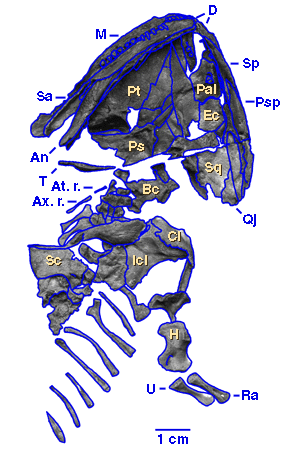Ariekanerpeton sigalovi
Michel Laurin
Introduction
Ariekanerpeton sigalovi was found in Lower Permian strata of Tadzhikistan. It is represented by over nine hundred compressed but otherwise well-preserved specimens. These specimens constitute one of the best known growth series of seymouriamorphs that includes skulls ranging from 6 mm to 54 mm in length (Ivakhnenko, 1981). However, the poor ossification of the skeleton of the largest known specimens suggests that even these are not fully mature.


Figure 1. One of the largest known specimens of Ariekanerpeton sigalovi. The poor ossification of the long bones and the absence of the quadrate suggest that this specimen is immature. Anatomical abbreviations: An, angular; At. r., atlantal rib; Ax. r., axial rib; Bc, braincase; Cl, clavicle; D, dentary; Ec, ectopterygoid; H, humerus; Icl, interclavicle; Ps, parasphenoid; Psp, postsplenial; Pt, pterygoid; Qj, quadratojugal; Ra, radius; Sa, surangular; Sc, scapula; Sp, splenial; Sq, squamosal; U, ulna.
Characteristics
Ariekanerpeton sigalovi, like other small seymouriamorphs, has been reconstructed with a broad, triangular skull, but recent study of this taxon suggests that the skull was slightly more narrow (Laurin, 1996). There is usually no contact between the postorbital and the supratemporal. This suggests that Ariekanerpeton is more closely related to Seymouria and Discosauriscus than to Utegenia, who consistently retained this contact in postmetamorphic specimens (the contact is occasionally present in Discosauriscus and Ariekanerpeton, but only rarely).
Ariekanerpeton had twenty-four presacral vertebrae. The neural arches are paired and disarticulated from the pleurocentra even in the largest known specimen, but this is probably a juvenile character.
Larval specimens of Ariekanerpeton had circular scales with concentric rings similar to those found in Discosauriscus, but postmetamorphic specimens appear to have lost them. Ariekanerpeton lacked the rectangular ventral scales (gastralia) found in most other early terrestrial choanates. The loss of gastralia suggests that Ariekanerpeton was more closely related to Discosauriscus than to Utegenia, who still had gastralia. In most fossil taxa, such characteristics of the integument are not known, but the great number of known specimens and their excellent preservation (scales are often preserved in the larval specimens) allow changes in the integument of Ariekanerpeton to be followed through its growth.
References
Ivakhnenko, M. F. 1981. Discosauriscidae from the Permian of Tadzhikistan. Paleontological Journal 1981: 90-102.
Laurin, M. 1996. A reevaluation of Ariekanerpeton, a Lower Permian seymouriamorph (Tetrapods: Batrachosauria) from Tadzhikistan. Journal of Vertebrate Paleontology 16 (4): 653-665.
Title Illustrations

| Scientific Name | Ariekanerpeton sigalovi |
|---|---|
| Location | Tadzhikistan |
| Comments | Skeleton of a small postmetamorphic specimen |
| Specimen Condition | Fossil |
| Image Use |
 This media file is licensed under the Creative Commons Attribution-NonCommercial License - Version 3.0. This media file is licensed under the Creative Commons Attribution-NonCommercial License - Version 3.0.
|
| Copyright |
© 1996 Michel Laurin

|
About This Page
I wish to thank Mr. John Hutchinson and my wife (Ms. Patricia Lai) for editing this page. I am indebted to Dr. David Maddison who provided invaluable help in formatting this page and in linking it with other pages on the Tree of Life. I thank Dr. Jozef Klembara for his useful comments on Discosauriscus.
Michel Laurin

Muséum National d'Histoire Naturelle, Paris, France
Correspondence regarding this page should be directed to Michel Laurin at
Page copyright © 1996 Michel Laurin
 Page: Tree of Life
Ariekanerpeton sigalovi.
Authored by
Michel Laurin.
The TEXT of this page is licensed under the
Creative Commons Attribution License - Version 3.0. Note that images and other media
featured on this page are each governed by their own license, and they may or may not be available
for reuse. Click on an image or a media link to access the media data window, which provides the
relevant licensing information. For the general terms and conditions of ToL material reuse and
redistribution, please see the Tree of Life Copyright
Policies.
Page: Tree of Life
Ariekanerpeton sigalovi.
Authored by
Michel Laurin.
The TEXT of this page is licensed under the
Creative Commons Attribution License - Version 3.0. Note that images and other media
featured on this page are each governed by their own license, and they may or may not be available
for reuse. Click on an image or a media link to access the media data window, which provides the
relevant licensing information. For the general terms and conditions of ToL material reuse and
redistribution, please see the Tree of Life Copyright
Policies.
Citing this page:
Laurin, Michel. 1996. Ariekanerpeton sigalovi. Version 01 January 1996. http://tolweb.org/Ariekanerpeton_sigalovi/17545/1996.01.01 in The Tree of Life Web Project, http://tolweb.org/









 Go to quick links
Go to quick search
Go to navigation for this section of the ToL site
Go to detailed links for the ToL site
Go to quick links
Go to quick search
Go to navigation for this section of the ToL site
Go to detailed links for the ToL site